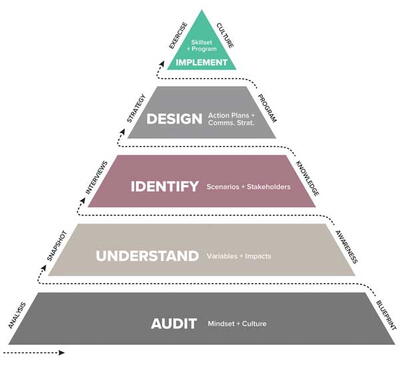
Melissa Agnes explains how one can transform today’s uncertainties into strategic opportunities.
By Melissa Agnes
From the impact of climate change, to acts of terror, to cyberattacks, and the list goes on, there’s no denying that we live in uncertain times and that with these uncertainties come increased risk and exposure.
It is true that we can never be entirely sure of when a catastrophic incident will strike. Will the impending hurricane pass around your community, or will its eye drive straight through? Will your district’s school or your city’s nightclub be the next to experience a devastating tragedy, or will your community remain safe from such horror? What if, however, I tell you that many of the uncertainties that leave you increasingly exposed can be anticipated and foreseen in ways that can give you, your team, and your organization a strategic advantage in trying times?
It Begins With Understanding the “Why”
When you take the time to understand the why behind today’s uncertainties, not only will the risks associated with them significantly decrease, but you also gain the advantage of preparing yourself to respond to any rising threat in ways that:
- Help you quickly get ahead of the narrative of the story and position your organization as the voice of trust, credibility, and leadership, which is the voice that your community will look to you to have in times of crisis.
- Foster increased trust and credibility in your team and organization, rather than suffering a potentially irreversible depreciation of those attributes.
- Ultimately, put you in a position to successfully work with your community’s emergency managers and, together, save more lives when the crisis is of a catastrophic nature.
Achieving this level of readiness requires more than the typical, stagnant crisis-management plan. Why? Because a plan is an extremely linear and siloed approach to a non-linear, cross-organizational situation.
With all the added exposure that things like social media, mobile technology, and the 24/7 news cycle bring to today’s crisis and issue management, that plan does little to truly serve in times of heightened risk.
Instead, today’s organizations gain the most strategic advantage when they approach their crisis readiness as the development of a program that is then embedded into the culture of the organization. Being crisis ready means managers have an entire organization of people who are trained and empowered to:
- Identify rising risk in real time, no matter what that risk may be, or how it may strike.
- Properly assess its material impact on community and the brand—is it an issue or is it a crisis?
- Respond in a way that both effectively manages the incident and fosters increased trust and credibility in the organization.
How to Gain a Strategic Advantage
If risk can strike from anywhere and we live in a world of uncertainty, then having a team that is equipped to instinctively identify, assess, and respond to any negative event in ways that foster increased trust and credibility in your organization, will put you at a strategic advantage to be the leader that your community needs you to be when it matters most.
The good news is that achieving this level of readiness is easier than most initially believe. In fact, there are four steps you can take today that will put your team at a strategic advantage in dire times.
Step 1: Identify and understand your risks.
This includes everything from your high-risk scenarios—the most-likely, high-impact issue and crisis scenarios that pertain to your organization and community—to the risks within those risks, including the risk of emotional relatability and the impact it threatens to have on an incident’s escalation.
To identify and understand your risk, you first need to begin by defining the difference between an “issue” and a “crisis” for your organization, and determine the thresholds where the crossover from one type of incident to the other lies.
Defining issue and crisis. As a baseline, a crisis is a negative event or situation that stops business as usual to some extent as it requires escalation straight to the top of leadership. It requires this escalation because the incident threatens long-term material impact on one to all of these five things:
- Stakeholders (people).
- The environment.
- Business operations.
- Your reputation.
- Your bottom line.
An issue, on the other hand, is a negative event or situation that does not stop business as usual because it does not require escalation straight to leadership. I refer to issue management as a form of business as usual on hyperdrive. Why? Because it does not threaten long-term material impact on any of those five attributes listed above.
An emergency, for example, is a negative event that requires real-time management. Depending, however, on the specifics of the emergency and the long-term material impact it threatens to have, any given emergency situation can be either an issue or a crisis.
Being able to quickly and accurately evaluate the long-term material impact of a given situation puts you and your team in a position to respond effectively in a way that can protect both the people of your community and the long-term reputation of your local government’s brand.
Action Item: Now that you have these definitions, your first task is to use them as a baseline to identify the most-likely, high-impact issues and crises to which your organization is most prone or vulnerable.
From there, define the thresholds and factors that would escalate each of your identified issues into crises, as well as de-escalate any given crisis down to an issue level.
This is a crisis-ready action that you are entirely in a position to take now. The simple act of doing this will help you gain better clarity and understanding about the risks of those uncertainties that are probably plaguing your leadership team.
Step 2: Develop strong emotional intelligence.
We can never be entirely sure when a negative event will go viral against our organization, increasing the real-time challenges, exposures, and impacts of the situation on the brand.
If you want to understand both sides of emotional relatability, however, you can then train your team to be able to quickly detect the probability of virality and get ahead of it in a way that de-escalates the situation and the long-term negative impact it threatens to have on your organization.
This Crisis Ready™ formula was designed to help your team quickly identify the potential of negative virality: Emotion + Relatability + Shareability = Heightened Risk of Virality. If a negative event has high emotional impact and if, by sharing it the sharer knows that emotion will relate to those within his or her network, it is likely to be shared, consumed, related to . . . shared, consumed, related to. . . and so forth, increasing its probability for virality.
Action Item: Teach your team to be able to quickly assess and evaluate the emotional relatability of a given situation, and then design an escalation protocol for team members to follow once strong emotional relatability is identified.
There’s also another element to developing strong emotional intelligence, which is to understand one of my Crisis ReadyTM rules: Logic will never overpower emotion.
If strong emotional relatability is detected, it doesn’t matter whether that emotion is rational or irrational, logical or illogical. It is real, it is powerful, and it will be impactful.
In order to reason with and overcome negative emotional relatability, your response to the incident needs to adhere to this Crisis ReadyTM formula: Heightened Risk of Virality = Logic (Validation + Relatability + Proof).
A common mistake I see is when leaders attempt to speak rationally in emotionally charged situations. To resonate logically in such instances, you have to first get into the hearts of those you are trying to reach.
This is done by taking your logical explanations, statistics, and commitments, and wrapping them in emotional relatability that matches, if not surpasses, that of the capacity of the negative sentiment.
Action Item: Teaching your team to detect emotional relatability and then to be able to act and communicate with emotional intelligence is one of the secrets to being crisis ready.
Step 3: Proactively find opportunities to consistently build trust.
Building up trust now, which means proactively finding ways to strengthen the relationships you share with your community, will give you powerful advantages in the midst of a crisis or a viral issue. Here are two major crisis-ready benefits of this approach:
- Truly knowing the members of your community and other stakeholder groups. This knowledge leads to your team instinctively understanding what is expected of it and how to meet those expectations in real time, in the midst of a breaking crisis or viral issue.
- Gaining the benefit of the doubt at the onset of an incident. In a world where controlling the narrative is next to impossible, gaining the benefit of the doubt at the start of a breaking incident means those who matter most to your organization will have the instinctive reflex to say, “We will wait to hear from the organization because we trust that it will do what’s right and be forthcoming with the information.
This offers a powerful advantage that only comes with earned trust.
Action Item: What does your team do each day to strengthen the trust it shares with your stakeholders? Trust is earned over time and it takes a cultural mindset of proactively seeking small opportunities to, as Captain Chris Hsiung of the Mountain View, California, Police Department says, “Make daily deposits in your bank of community trust.”
Step 4: Choose to embed a crisis-ready culture.
While I’ve shared some powerful, actionable strategies with you here, there are five distinct phases to becoming crisis ready and truly building out a culture of crisis readiness (see Figure 1).

Having a true culture of readiness takes commitment and dedication, and the rewards are immense and far exceed the sole acts of issue and crisis management.
The current status quo of developing a linear and siloed crisis management plan that sits on a shelf collecting dust does not suffice in today’s uncertain world of increased risk and exposure. In fact, this approach puts today’s organizations at a disadvantage.
Instead, the objective is to embed a culture of readiness whereby the entire team is empowered to detect, assess, and respond to any negative incident in a way that does right by stakeholders and increases the trust and credibility in the organization.
My Crisis ReadyTM model, outlined in my book, takes you through the process of designing your Crisis ReadyTM program and embedding a culture that will help you mitigate the risks of uncertainty and strengthen your team’s leadership for your community.
I wish you and your community all the invincibility you are committed to earning.

Melissa Agnes, a presenter at ICMA’s 2018 Annual Conference, is an adviser on crisis management, New York, New York, and author of Crisis Ready: Building an Invincible Brand in an Uncertain World (Mascot Books, 2018).
New, Reduced Membership Dues
A new, reduced dues rate is available for CAOs/ACAOs, along with additional discounts for those in smaller communities, has been implemented. Learn more and be sure to join or renew today!
